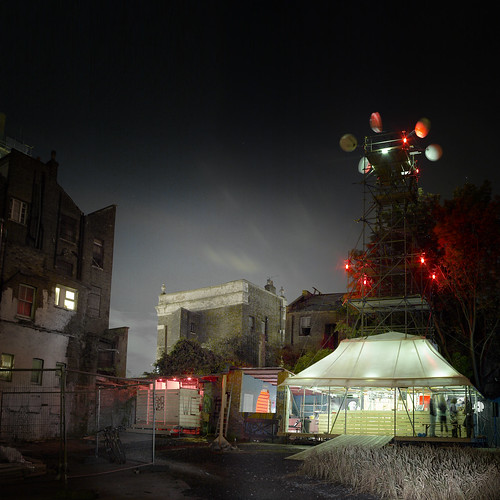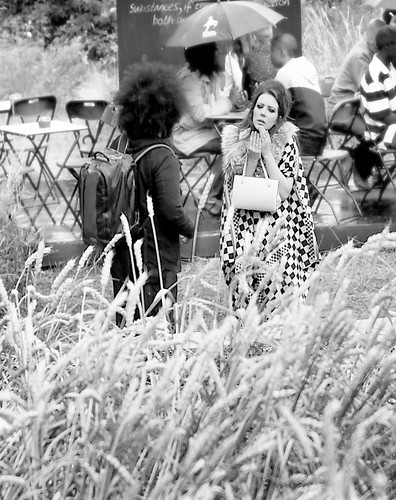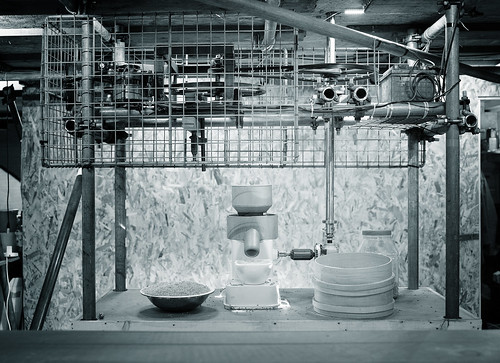
Haus der Vorstellung, P2 residence, 2008 © raumlaborberlin
For the P2 residency, Raumlabor mapped the Haus der Vorstellung, a typical mass produced flat in Berlin and overlapped it with a "government-controlled" type of living space (Plattenbau, P2). While the first type of flat was delimited using white masking tape, the second was constructed in 3D using a collection of discarded doors re-cycled into furniture.

© raumlaborberlin
The political transcending of an alienating environment meets a poetic mise-en-abime : playing with conventional architecture by accumulating spaces that mirror each other, making the subversive contrast. Creating space for poetry challenges common urban practices and rethink the concept of housing estates.
The floor mapping strangely echoes archeological plans in its highlighting of superposed rites - when mapping superposition retraces different eras and practices.
The project investigates the Present political context in the way the Situationists used to - the "derive" and escapist wish put in practice here recalls Guy Debord's psychogeographical relief.

White spots, Munich
2006 © Raumlaborberlin
White spots also disrupted the normality of a residential area of Munich. During that playful performance, a group of thirty three cars drew unforeseen white lines along the sides of deserted streets. The awareness created by the transformation of a daily perception, the boring repetitiveness of urban ghettos, provoked conflicts between the artists and the locals.
Thanks to Heike Pauketat
The way out of the Situationists was not to wait for a distant revolution but to reinvent everyday life here and now. To transform the perception of the world and to change the structure of society is the same thing. (...) They therefore tried to construct situations which disrupt the ordinary and normal in order to jolt people out of their customary ways of thinking and acting.
Demanding the impossible, A history of Anarchism, Peter Marshall, 1992, Fontana Press [p.551-53].
 Dalston Mill - 2009 © Exyzt collective
Passing the threshold of the Mill provokes an instant sense of peace and loss of urban time (click for photos).
It was built by Exyzt to re-stage Agnes Denes's Weatfield and was shown as part of Radical nature at the Barbican centre.
The Mill is a busy hive for the people of Dalston : a DJ passes-by to use the sound system, a designer cycled with her mobile kitchen to help baking cakes, pizzas are being cooked by Exyzt's architects and parents chill out on Southwark Lido deck chairs while their children run up and down the garden's alleys.
Hidden from the city's surveillance, the Mill is a shelter against the noise and pollution of Dalston junction, reclaiming the land has common space.
Dalston Mill - 2009 © Exyzt collective
Passing the threshold of the Mill provokes an instant sense of peace and loss of urban time (click for photos).
It was built by Exyzt to re-stage Agnes Denes's Weatfield and was shown as part of Radical nature at the Barbican centre.
The Mill is a busy hive for the people of Dalston : a DJ passes-by to use the sound system, a designer cycled with her mobile kitchen to help baking cakes, pizzas are being cooked by Exyzt's architects and parents chill out on Southwark Lido deck chairs while their children run up and down the garden's alleys.
Hidden from the city's surveillance, the Mill is a shelter against the noise and pollution of Dalston junction, reclaiming the land has common space.
 © Analucia Feracci
© Analucia Feracci
It isn't an escapist hideout but an invitation to make things happen : a city within the city, with bakery, workshops, bar, sound system and its own currency, the Dalston slice, baked and traded for goods and services to link with local traders - an experiment by the Collaborators guide.
The Mill is hanted by the reggae scene of the Four Aces Club from the 60's, now demolished by promoters, a context which reinforces the need for a social hang-out.

 © Exyzt collective flickr
© Exyzt collective flickr
The Mill is made of a succession of scafoldings to mirror the building site opposite its entrance. The an-architectural form has turned into a living space with tents and showers for the architects of Exyzt.
The site exists above a disused train track : a line of gravel delimits the area that belongs to the City Council while the wheatfield draws the part that belongs to the owner of the adjacent superstore. Sandwiched between abandoned buildings and a car park, that space is yet too narrow to attract developers.
 © Exyzt collective flickr
The Mill also functions in an organic manner : the turbines produce electricity for the bar/ sound system, distributing wind energy in a stable manner, bringing nothing between the natural source of energy and the process of grinding. Like Tibo from Exyzt points out 'no need to use solar panels on a house roof if we use hot running water pipes - why rely on electricity always ?'.
© Exyzt collective flickr
The Mill also functions in an organic manner : the turbines produce electricity for the bar/ sound system, distributing wind energy in a stable manner, bringing nothing between the natural source of energy and the process of grinding. Like Tibo from Exyzt points out 'no need to use solar panels on a house roof if we use hot running water pipes - why rely on electricity always ?'.
In the context of Radical Nature, which explores the relationships between man and the environment, the Mill gives local people a temporary autonomous space to celebrate human interaction and urban life.
Thanks to Tibo Labat and Nicolas Henninger







